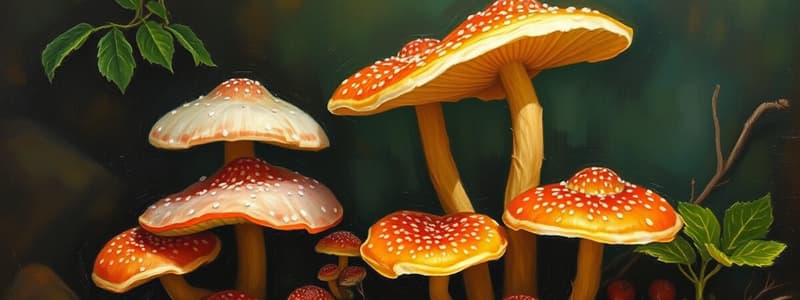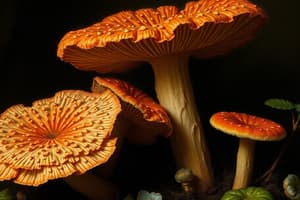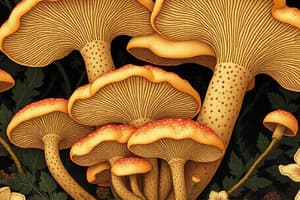Podcast
Questions and Answers
Distinguish between septate and coenocytic hyphae.
Distinguish between septate and coenocytic hyphae.
Septate hyphae are divided into individual sections that keep organelles in each section but allow cytoplasm to flow freely through the hypha. Coenocytic hyphae are one continuous mass of hyphae and organelles that has no separation.
Distinguish between monokaryotic & dikaryotic, and homokaryotic and heterokaryotic fungi.
Distinguish between monokaryotic & dikaryotic, and homokaryotic and heterokaryotic fungi.
Monokaryotic fungi have one nucleus per hypha compartment. Dikaryotic fungi have two nuclei per hypha compartment, each from a different parent. Homokaryotic fungi have nuclei with the same genetic makeup in their mycelium. Heterokaryotic fungi have two or more different types of nuclei within a mycelium.
What is distinctive about centrioles and fungi?
What is distinctive about centrioles and fungi?
All fungi lack centrioles (except Chytrids); the spindle is inside the nuclear membrane.
Distinguish between yeast form and hyphal form.
Distinguish between yeast form and hyphal form.
What is similar between how yeasts and hyphae grow? What is different?
What is similar between how yeasts and hyphae grow? What is different?
List the features of Phylum Chytridiomycota.
List the features of Phylum Chytridiomycota.
List the features of Phylum Zygomycota.
List the features of Phylum Zygomycota.
List the features of Phylum Basidiomycota.
List the features of Phylum Basidiomycota.
What are the three types of ascocarps?
What are the three types of ascocarps?
List the features of Phylum Ascomycota.
List the features of Phylum Ascomycota.
Distinguish between a sporangium and a sporangiophore.
Distinguish between a sporangium and a sporangiophore.
Describe the range of fungal symbioses.
Describe the range of fungal symbioses.
Distinguish between obligate and facultative relationships.
Distinguish between obligate and facultative relationships.
Distinguish between arbuscular mycorrhizae and ectomycorrhizae.
Distinguish between arbuscular mycorrhizae and ectomycorrhizae.
Explain why fungal infections in humans or other animals are harder to treat than bacterial or viral infections.
Explain why fungal infections in humans or other animals are harder to treat than bacterial or viral infections.
Distinguish between crustose, foliose, and fruticose lichen forms.
Distinguish between crustose, foliose, and fruticose lichen forms.
Which of the fungi are flagellated, aquatic organisms?
Which of the fungi are flagellated, aquatic organisms?
Flashcards are hidden until you start studying
Study Notes
Distinction of Hyphae Types
- Septate Hyphae: Divided into individual sections, allowing for organelle localization and cytoplasmic flow.
- Coenocytic Hyphae: Continuous mass without separations, containing multiple nuclei and organelles.
Fungal Nucleus Types
- Monokaryotic: Fungi with one nucleus per hyphal compartment.
- Dikaryotic: Fungi with two nuclei from different parents in each compartment.
- Homokaryotic: Fungi with genetically identical nuclei in mycelium.
- Heterokaryotic: Fungi with two or more genetically different nuclei in mycelium.
Centrioles in Fungi
- All fungi, except Chytrids, lack centrioles; the spindle apparatus forms within the nuclear membrane.
Growth Forms of Fungi
- Yeast Form: Grows by budding, involving asexual reproduction.
- Hyphal Form: Grows at the tips, utilizing tip extension for growth.
Phylum Chytridiomycota Characteristics
- Exclusively aquatic fungi group.
- Nutritional roles as decomposers and parasites.
- Unicellular or hyphal, with coenocytic hyphae that grow at tips.
- Flagellated cells: one posterior flagellum for motility.
- Reproduce asexually through motile zoospores.
Phylum Zygomycota Characteristics
- Fungi are terrestrial and coenocytic.
- Reproduction by zygotic meiosis, no flagella present.
- Asexual spores formed in sporangia and released by wind.
- Sexual reproduction through conjugation forming zygosporangia.
Phylum Basidiomycota Characteristics
- Terrestrial, including decomposers and plant parasites.
- Forms positive symbiotic relationships with plants.
- Composed of septate hyphae, primarily reproducing sexually via basidiospores.
- Forms lichens in obligate and facultative symbiotic relationships.
Types of Ascocarps
- Apothecium: Cup or saucer-shaped, large ascocarps.
- Perithecium: Flask-shaped with a pore, smaller size.
- Cleistothecium: Spherical and poreless, smallest type.
Phylum Ascomycota Characteristics
- Terrestrial fungi with either septate hyphae or yeast forms.
- No flagella; reproduction occurs asexually or via asci in ascocarps.
- Sexual reproduction involves karyogamy and meiosis resulting in eight ascospores.
Sporangium vs. Sporangiophore
- Sporangium: Structure for spore production.
- Sporangiophore: Specialized supportive branch for sporangium.
Fungal Symbiotic Relationships
- Mycorrhizal: Fungi and plant roots partnership enhancing nutrient exchange.
- Commensal: One organism benefits, the other remains unaffected.
- Mutualistic: Both organisms benefit from the relationship.
Obligate vs. Facultative Relationships
- Obligate Relationships: Essential for survival of one or both partners.
- Facultative Relationships: Partners can survive independently.
Arbuscular vs. Ectomycorrhizae
- Arbuscular Mycorrhizae: Infiltrate plant root cells for nutrient exchange.
- Ectomycorrhizae: Surround plant root without entering cells.
Challenges of Fungal Infections
- Fungal infections are harder to treat due to eukaryotic nature; treatments targeting prokaryotic organisms typically harm both the fungus and the host.
Lichen Forms
- Crustose: Thin, crust-like, adheres tightly to surfaces.
- Foliose: Leaf-like, easily removable from substrate.
- Fruticose: Branched structures resembling small bushes.
Flagellated Aquatic Fungi
- Only Phylum Chytridiomycota consists of flagellated, aquatic organisms.
Studying That Suits You
Use AI to generate personalized quizzes and flashcards to suit your learning preferences.




